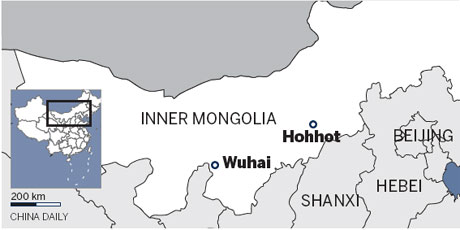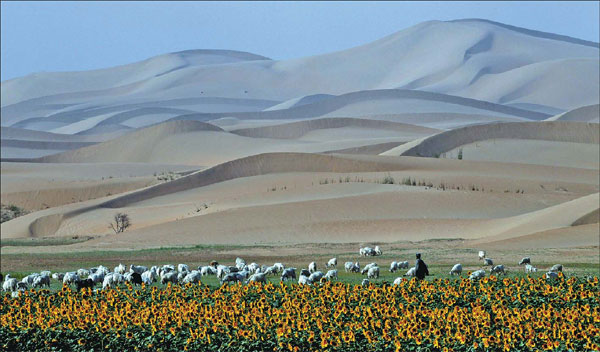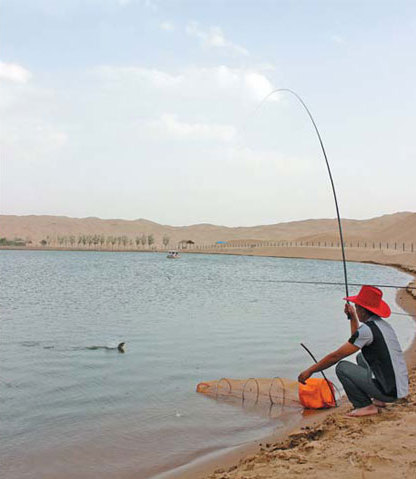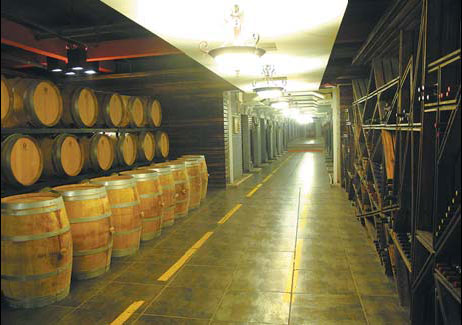Desert oasis
Updated: 2013-06-13 07:36
By Wang Kaihao (China Daily)
|
||||||||
|
Wetlands spread like a green belt along the Yellow River, making Wuhai a colorful haven in the depth of the Gobi Desert. Provided to China Daily |
|
A local man pulls his catch out of the lake in Jinshawan, a popular tourist site in Wuhai. Wang Kaihao / China Daily |
|
The underground cellar of Chateau Hansen is home to some of the city's best wines. Wang Kaihao / China Daily |
Most tourists to the Inner Mongolia autonomous region seek out the famous grasslands, but Wang Kaihao finds a kaleidoscope of colors in Wuhai.
Seeing the Gobi Desert from the window of an airplane does not give the best first impression, so it is a relief to see a green belt spread along the Yellow River. Wuhai, here I am. From above, Wuhai looks tiny. A speck in the vast 1.18 million sq km spread of the Inner Mongolia autonomous region. With an area of about 2,000 sq km and a population slightly over half a million - less than a single major residential area in Beijing - tourists usually skip Wuhai in favor of Inner Mongolia's famous grasslands.
However, I am unexpectedly overjoyed to find a kaleidoscope of colors in this tiny spot in the west of the autonomous region.
Wuhai boasts a rich coal reserve. Although some pioneers began to dig coal in 1864, large-scale exploitation only began in the 1950s, attracting people from all over the country to settle down.
Wuhai Coal Museum, designed in the shape of a lump of coal, gives a fascinating history of how this mining hub became a city.
It is also a perfect place for me to refresh my high school chemistry.

The city's name is a combination of Wuda and Haibowan, two major mining districts. By pure coincidence, the literal meaning of Wuhai is "sea of black gold" in Chinese. It is a nickname locals are proud of.
Wuhai does not have rich Mongolian traditions like other places in the region. There are only about 20,000 people from the Mongolian ethnic group living here.
Nevertheless, I still spot a museum exhibiting nearly 1,000 pieces of traditional Mongolian furniture and domestic decorations. These delicately painted items reflect Mongolian beliefs and traditions.
I also find a 30-square-meter image of Genghis Khan, which claims to be one of the world's largest hand-knotted woolen tapestries.
The city boasts many different cultures, and Mongolian traditions only make up a small part of Wuhai's rich cultural mix. Migrants transplant customs from their homelands here. Ballads and music from different regions throughout the country can be found in the city.
It is greatly beneficial for me, because I am able to enjoy different styles of food within a couple of days.
However, no matter which cultural background locals come from, they share an affection for one important thing: wine.
Wuhai's climate is ideal for growing grapes. Many migrants brought grape seedlings when they moved to the area, and a grape trellis was a must-have in local backyards in the 1960s and '70s.
After a short trip to the newly built Wuhai Wine Museum - a three-story building in the shape of a grape - I go to the Chateau Hansen vineyard in the north of the city.
Cabernet Sauvignon, Cabernet Franc and Merlot are major varieties, but they are combined with some local breeds to better handle the sandy soil.
On a scorching summer day, it is relaxing to wander around the underground wine cellar and taste some local specialties.
Hundreds of oak barrels imported from France contain not only fine wine, but also the collective memory of the people of Wuhai.
I am an amateur drinker, but I cannot help taking just one more sip.
After trying these top-tier wine, I decide to look for the best fish in town.
The Yellow River provides Wuhai with abundant fresh fish, which is uncommon in China's Northwestern cities.
I have a surprising discovery on the way to a fishing village by the river.
A wetland called Longyouwan, which literally means "the bay where dragons swim", makes me stop to take photos.
The Yellow River's water is clear and the desert spreads into the distance across the water. The Helan Mountains provide the scenery on the other side.
A friendly old fisherman invites me to take a rest in his cabin. Sitting by the window watching the landscape and listening to his tales of fishing, the busyness of city life fades away.
Returning to the downtown area, I notice another natural wonder: two huge sand dunes by the highway.
It is said the sand blew from the desert on the other side of Yellow River hundreds of years ago. Locals called it Jinshawan, meaning Bay of Golden Sand.
Because my limited time in Wuhai does not allow me to go across the river to explore the desert, I decide to have my adventure here.
Some people are fishing by a small lake between the two dunes, cheering every time they get a catch, but my attention has been caught by the dune buggies.
Driving the buggies over the sand dunes is a little like being on a roller-coaster, and I am left feeling a little dizzy. Perhaps next time I will take a camel ride instead.
Contact the writer at wangkaihao@chinadaily.com.cn.
Yang Fang contributed to this story.

(China Daily USA 06/13/2013 page9)

 Michelle lays roses at site along Berlin Wall
Michelle lays roses at site along Berlin Wall
 Historic space lecture in Tiangong-1 commences
Historic space lecture in Tiangong-1 commences
 'Sopranos' Star James Gandolfini dead at 51
'Sopranos' Star James Gandolfini dead at 51
 UN: Number of refugees hits 18-year high
UN: Number of refugees hits 18-year high
 Slide: Jet exercises from aircraft carrier
Slide: Jet exercises from aircraft carrier
 Talks establish fishery hotline
Talks establish fishery hotline
 Foreign buyers eye Chinese drones
Foreign buyers eye Chinese drones
 UN chief hails China's peacekeepers
UN chief hails China's peacekeepers
Most Viewed
Editor's Picks

|

|

|

|

|

|
Today's Top News
Shenzhou X astronaut gives lecture today
US told to reassess duties on Chinese paper
Chinese seek greater share of satellite market
Russia rejects Obama's nuke cut proposal
US immigration bill sees Senate breakthrough
Brazilian cities revoke fare hikes
Moody's warns on China's local govt debt
Air quality in major cities drops in May
US Weekly

|

|










